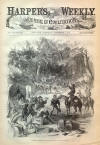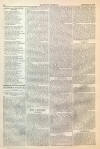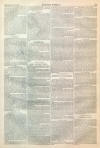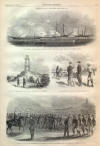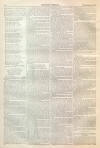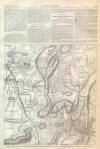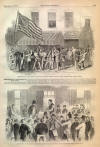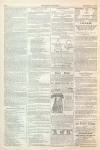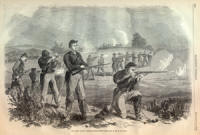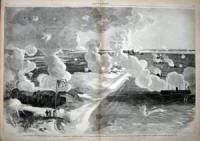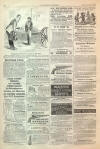Mosby's Guerrillas
|
|
This Site:
|
SEPTEMBER 5, 1863.] HARPER'S WEEKLY. 567 (Previous Page) were posted around the town so as to prevent all escape, and the work of pillage and murder at once commenced. The attack was wholly unexpected, and there was not the least show of resistance. The citizens were massacred by the light of their burning homes, and their bodies flung into wells and cisterns. In one case twelve men were driven into a building, where they were shot down, and the house burned over their bodies. The number of victims is stated at 180, including the Mayor and the principal citizens. Only one hotel was left standing, and this was spared because the guerrilla chief had been formerly entertained there free of expense. Two of the banks were plundered, and the third escaped because the marauders could not force the safe in time. The total loss of property is put down at two millions of dollars. No other such instance of wanton brutality has occurred during the American war. The names of Nena Sahib in India, Cut-Nose in Minnesota, and Quantrill in Kansas will go down in history together. MORRIS ISLAND SKETCHES.OUR special correspondent before Charleston sends us a series of sketches from Morris Island which we reproduce on page 565. No 1 shows the Mortar Schooners and Wooden Gun-boats bombarding Fort Wagner and Battery Gregg. No. 2 is a view of the Light-house at Light-house Inlet, destroyed by the rebels in February, 1862. The lower part of the Light-house was of brick: this was blown up, and the debris of the structure lay scattered around, as shown by our artist. No. 3 represents the Examining of Passes on the beach at Morris Island, our iron-clad fleet being visible in the distance. No. 4 represents the Grand Guard marching to, and the Negro Fatigue-Party returning at dark from, the trenches in front of Fort Wagner. The Grand Guard are in full uniform without knapsacks. The Fatigue-Party, in shirt sleeves, with trowsers rolled up, have their blankets slung over the right shoulder, and carry their canteens and haversacks. The officer is white. MOSEBY'S GUERRILLAS.INSTEAD of "Stonewall Jackson" with his dashing achievements, the rebel cavalry in Virginia have now nothing better to show than the performances of Moseby and his guerrillas, "citizens by day and soldiers by night." Aided by a perfect knowledge of the country and by information furnished by their sympathizers, they have succeeded in capturing quite a number of sutlers' trains, and escaping with a portion of their booty. These guerrilla enterprises, while they exert no influence upon the issue of the war, are annoying, and must be prevented. They are only possible through the connivance of the inhabitants of the region where they take place, and these should be held accountable for all the damage done by their friends. If this rule is strictly enforced, the aiders and abettors of these marauding gangs will find that they are carrying on a losing business. BOMBARDMENT OF CHARLESTON FORTS.THE formal attack upon Fort Sumter was commenced on the 17th of August. The results of the first day's work is given in the following extracts from the official report of Admiral Dahlgren, dated on the 18th: Yesterday was begun another series of operations against the enemy's works. Early in the morning General Gilmore opened all his batteries upon Fort Sumter, firing over Fort Wagner and the intervening space. About the same time I moved up the entire available naval force, leading with my flag in the Weehawken, followed by the Kaatskill, Nahant, and Montauk, the Passaic and Patapsco in reserve for Sumter—the Ironsides in position opposite to Wagner, and the gun-boats at long range. As the tide rose the Weehawken was closed to about 450 yards off Wagner; the other three Monitors followed, and the Ironsides was taken as near as her great draft of water permitted. After a steady and well-directed fire Wagner was silenced about 9.13 A.M., and that of our own vessels was slackened in consequence. Meanwhile the fire of our shore batteries was working effectually upon the gorge of Sumter, which appeared to have been strengthened in every possible manner. At this time the flag was shifted to the Passaic, which, with the Patapsco, both having rifle-guns, steamed up the channel until within 2000 yards of Fort Sumter, when fire was opened on the gorge, angle, and southeast front of the work. The Patapsco fired very well, and is believed to have struck the southeast front nine consecutive times. To all this Sumter scarcely replied. Wagner was silenced, and Battery Gregg alone maintained a deliberate fire at the Passaic and Patapsco. It was now noon; the men had been hard at work from daybreak, and needed rest; so I withdrew the vessels to give them dinner. During the afternoon our shore batteries continued the fire at Sumter, with little or no reply from the enemy, and I contented myself with sending up the Passaic and Patapsco to prevent Wagner from repairing damages. The fort replied briskly, but in a short time left off firing. I am not able to state with exactness the result of the day's work, but I am well satisfied with what a distinct view of Sumter allowed me. Our entire power is not yet developed, as it will be daily, while the enemy is damaged without being able to repair. The officers and men of the vessels have done their duty well, and will continue to do so. All went well with us, save one sad exception, Captain Rodgers, my Chief-of-Staff, was killed, as well as Pay-master Woodbury, who was standing near him. It is but natural that I should feel deeply the loss thus sustained, for the close and confidential relations which the duties of fleet captain necessarily occasioned impressed me deeply with the worth of Captain Rodgers. Brave, intelligent, and highly capable, devoted to his duty and to the flag under which he passed his life, the country can not afford to lose such men. Of a kind and generous nature, he was always prompt to give relief when he could. I have directed that all respect be paid to his remains, and the country will not, I am sure, omit to honor the memory of one who has not spared his life in her hour of trial. Any further details of the siege of Charleston that come to hand will be found in the column of general news on page 563. MAP OF THAT PART OF TENNESSEE THROUGH WHICH GENERAL ROSECRANS ADVANCED FROM MURFREESBORO TO TULLAHOMA AND CHATTANOOGA.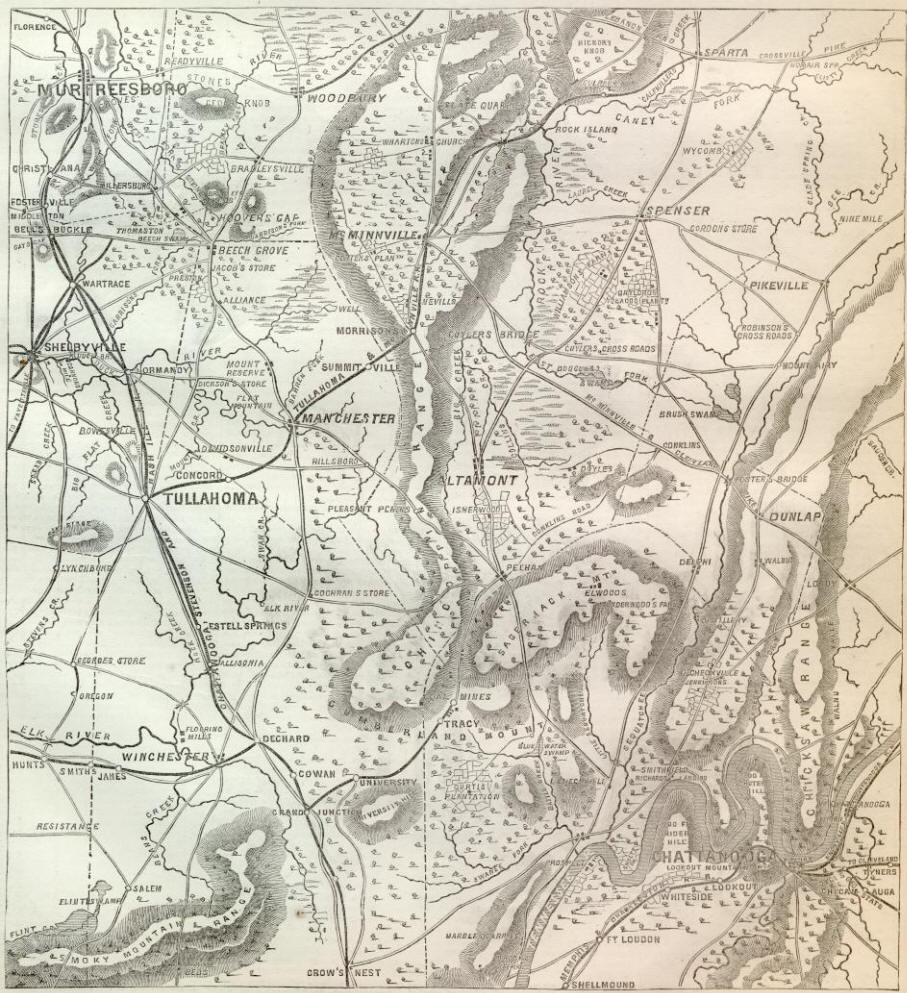 |
||||||||||||||||||||||
|
|
||
|
|
Site Copyright 2003-2018 Son of the South. For Questions or comments about this collection, contact paul@sonofthesouth.net |
|
|
Are you Scared and Confused? Read My Snake Story, a story of hope and encouragement, to help you face your fears. |
||
